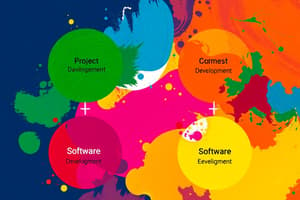Podcast
Questions and Answers
What are life cycle methodologies often referred to as?
What are life cycle methodologies often referred to as?
- Software Development Life Cycle (SDLC) methodologies (correct)
- Software Deployment strategies
- Project Management structures
- Sequential approaches
Which of the following is NOT a key component of life cycle methodologies?
Which of the following is NOT a key component of life cycle methodologies?
- Documentation
- Flexibility
- Communication and Collaboration
- Risk Management (correct)
What is a common phase in the software development process according to the text?
What is a common phase in the software development process according to the text?
- Deployment (correct)
- Budget Approval
- Project Analysis
- User Training
Which type of methodology provides a systematic process to guide the development team through various phases?
Which type of methodology provides a systematic process to guide the development team through various phases?
Which of the following is an essential objective of the planning phase in software development?
Which of the following is an essential objective of the planning phase in software development?
What is the primary objective of the Requirements Analysis phase in software development?
What is the primary objective of the Requirements Analysis phase in software development?
Which phase involves transforming the design into executable code in software development?
Which phase involves transforming the design into executable code in software development?
What is the main goal of the Design phase in software development?
What is the main goal of the Design phase in software development?
In which phase of software development are unit testing, integration testing, system testing, and acceptance testing typically performed?
In which phase of software development are unit testing, integration testing, system testing, and acceptance testing typically performed?
What is the primary goal of the Deployment phase in software development?
What is the primary goal of the Deployment phase in software development?
Which phase involves addressing bugs, making updates, and implementing improvements to the software?
Which phase involves addressing bugs, making updates, and implementing improvements to the software?
What is one of the key disadvantages of the Waterfall methodology?
What is one of the key disadvantages of the Waterfall methodology?
In which phase of the Waterfall methodology, each stage of the workflow needs to be completed before moving on to the next step?
In which phase of the Waterfall methodology, each stage of the workflow needs to be completed before moving on to the next step?
Which project management method is known for its ability to handle projects where objectives are clearly outlined from the beginning?
Which project management method is known for its ability to handle projects where objectives are clearly outlined from the beginning?
What type of projects is the Waterfall methodology NOT suitable for?
What type of projects is the Waterfall methodology NOT suitable for?
Which phase in a project aligns solutions with project requirements according to the text?
Which phase in a project aligns solutions with project requirements according to the text?
Why is rapid prototyping mentioned as a use case for Agile methodology?
Why is rapid prototyping mentioned as a use case for Agile methodology?
Study Notes
Software Development Life Cycle (SDLC)
- SDLC methodologies provide a systematic process to guide the development team through various phases, ensuring that the software is well-planned, efficiently constructed, thoroughly tested, and effectively deployed.
Phases of SDLC
- A series of distinct stages or phases that define the tasks and activities to be performed during the software development process.
- Common phases include:
- Project initiation, feasibility analysis, resource planning, and initial risk assessment
- Requirements analysis: gather and document detailed requirements from stakeholders
- Design: create a blueprint for the software based on the requirements
- Implementation (coding): transform the design into executable code
- Testing: validate and verify that the software meets the specified requirements
- Deployment: release the software for end-users or clients
- Maintenance: sustain and enhance the software over time
Life Cycle Methodologies
- Life cycle methodologies, often referred to as SDLC methodologies, are structured approaches or frameworks used in the development, deployment, and maintenance of software applications.
- The choice of a specific life cycle methodology depends on factors such as the nature of the project, organizational preferences, and project requirements.
Waterfall Methodology
- A widely used project management method with a linear approach.
- Each stage of the workflow needs to be completed before moving on to the next step.
- Suitable for projects where the objectives are clearly outlined from the beginning.
- Best suited for projects with well-defined and stable requirements, particularly when a quick initial delivery is more critical than long-term maintainability.
Advantages of Waterfall Methodology
- Quick initial delivery: allows for the rapid development of a working version.
- Flexibility: provides flexibility to adapt to changing requirements, as changes can be made at any stage of development.
Studying That Suits You
Use AI to generate personalized quizzes and flashcards to suit your learning preferences.
Description
Learn about the different phases of the software development lifecycle including project initiation, requirements analysis, and design. Explore activities involved in each phase from gathering stakeholder requirements to creating a blueprint for the software.




